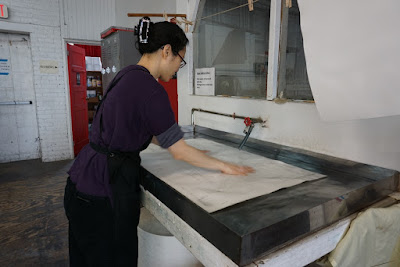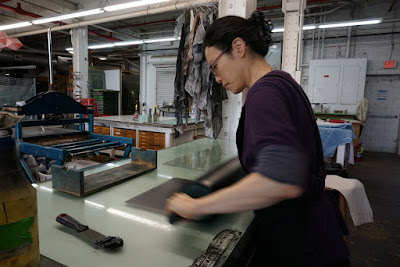I love
Zygote, it's a wonderful community of artists, printers, and colleagues, but because they don't have A/C and I cannot print when it gets hot and humid, I only print there during certain times of year. I would have started in April but Covid said no, so I rented a month in May and worked as much as my body would allow, and then some (I know, not a great move but the access in the right weather is so precious and fleeting). My process is so simple but it can really confound people. Basically, I'm pressure printing bark lace and hammered bark, and then pulling ghosts from the imprint left on the plate. Skipping the step of mixing ink, you have to spread ink onto the slab to get going.
Then you roll it out. I am not actually strong enough to use this roller and the height of the table is just a wee high for me, so my shoulders and upper body are screaming at me daily. I'm trying to get even coverage on the roller, enough ink but not too much, and no bits of dried up ink in the mix.
Then I have to cover the entire plate (a 2x3-ft piece of plexi that I've already beveled by hand with a file, the LEAST FUN part of this whole process but necessary to protect the press blankets) with an even amount of ink. Again, b/c of my physical limitations, it's not terribly even but can pass for it!
On the bed of the etching press, I set up the bark that I want to print, though the grand thing with pressure printing is that the matrix never touches ink (aside from any that comes thru thin hanji). Later, this bark lace will become the skirt of a dress.
Then I place the hanji that will receive ink onto the bark, where I want it.
Then somehow I have to flip the plate that is inked up, upside down, without getting excessive fingerprints onto it, and get it onto the hanji exactly where I want. Since I'm not a classically trained printmaker, I am extremely bad at registration. Or, I am generally bad at registration b/c I always try to eyeball it and that is not how you should work. There are ways to set up registration guides and I completely ignore that step. Why? B/c this is all paper being printed as a pattern that will be sewn anyhow, not to be single 2D prints that hang on the wall.
Clean newsprint goes on top of the whole mess so the blankets are protected.
Then three separate blankets go on top of the pile: a sizing catcher absorbs any sizing that might come out of the wet paper (this is null in this pass since I have no wet paper AND my hanji is not sized. But we're talking traditional printing). The middle blanket is a cushion that is thicker. The top blanket is the pusher, which is rougher so that it will push the entire thing through the rollers so they don't slide around and not move. These are expensive sets of blankets and see a LOT of wear in a community studio. Want to fund a new set so I don't get weird halos in the middle of my plate? I think they are $450,
you can donate here.
Once the blankets are down, you crank the wheel to get the whole thing to pass through the top cylinder and end up on the other side of the press.
Then you reverse the whole thing (blankets off, newsprint off, etc.) and you can kind of see the print falling away from the plate. That's not ACTUALLY how I work, but that's what I did for the picture so it makes a little more sense. Usually I flip the plate and the hanji stuck to it, and remove the paper from the top. Then I slide away the bark, that is sitting on newsprint (to protect the bed of the press and also for easy sliding removal), and put the plate face up. Now it has the imprint of the bark on it and I can get another print! Remarkably in this process, BOTH images will be right-reading. No need to think about reversed images as in relief and other traditional processes.

Before I was doing all that, I had started soaking paper in water. Usually you use European style printing papers, which are made of cotton and short fibers, and very absorbent. I use them behind the thin hanji that I cannot soak in water like this, to help pull my prints. But for this ghost, I am going to actually print onto the Euro-paper b/c it is built to suck up so much ink and makes a gorgeous impression. For fun!
Drip off the water, and then turn around to place between two clean towels.
Lightly run a rolling pin over the entire sheet of paper so it's not dripping or unevenly damp. Then walk it back over to the press without getting dirty fingerprints onto the paper (my old intaglio teacher taught us to use expired Metrocards, folded, to transport cleanly, but those are hard to find these days) OR tearing it (or running into something dirty or somebody).
In the ghost phase, the plate is face up on the bed of the press, the damp paper on top, newsprint and blankets on top of that, and crank away. Sometimes you want to increase pressure on the press at this time, but I already have it kind of hard (my plate was starting to shatter and a corner broke off after a month of printing. Bad technique! But it's my plate).
At the very end, I did a little relief printing, directly rolling ink onto bark, and printing those, but I realized that even though the process is so hard on me, I prefer pressure printing (the ghost harvest is the best bonus for all of the rolling up!).
Now that I'm done in the shop, I have to sew these into dresses for a couple solo museum shows next year. Ideally I'd let all of the prints dry more but there's no time! Zygote is a real treasure in Cleveland, please support them thru donations or come to the annual benefit during the summer solstice! I would love to see you there.















